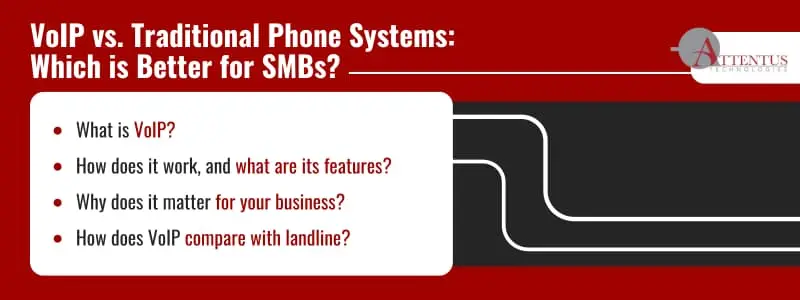Discover the advantages of VoIP over traditional phone systems and which is right for your business.

Are you looking to make your communication more cost-efficient, scalable, and worker-friendly, all while remaining responsive to customers?
It might be time to consider switching to voice over internet protocol (VoIP) for business.
If you’ve heard of it but don’t know much about it, no stress. Let’s strip away the jargon so you know exactly what VoIP is, how it works, and why it matters for your business.
How VoIP Works for Business
VoIP is a unified phone communication system that allows you to make calls over the internet via smart devices.
VoIP-capable instruments could include a traditional-looking telephone or cordless phone (either Wi-Fi-enabled or decked) connected to your network, or having VoIP as an application on a smartphone or computer. This is the most common way businesses use VoIP because:
- It’s easier to manage
- It doesn’t require the purchase of physical equipment or wiring
- It allows employees to work from anywhere
The process is simple once you set up VoIP for business:
- You can initiate a call by either pressing an icon or dialling a phone number.
- A session initiation protocol (SIP) takes what you’ve initiated, sends it to the internet through a media gateway, and then to the destination. You can think of SIP as the “air traffic controller” of how the call gets set up.
- The person on the other end receives the call and you start talking.
- An encoder on your VoIP system samples your voice many times per second while making recordings, almost like an MP3 player.
- The encoder turns those recordings into little data packets, which ride across your ethernet wires or Wi-FI (depending on the setup) and go to the intended destination.
- They are then converted into analog audio.
Listening happens in reverse. Think of it as tiny MP3 files being downloaded from the internet, stored on your phone, and then converted into analog audio that you can hear through the earpiece.
Now that you know what business VoIP phone systems are and how they work, let’s tackle a crucial question. Why would you want one?
Benefits of VoIP for Businesses
Affordability, flexibility, scalability, and security are the four main factors driving the adoption of VoIP for business in the SMB space.
1. Affordability
Consider traditional telephone services here in the U.S. A typical line might run you anywhere from $25 to $75 per month, and that’s before taking into account the cost of hardware.
In contrast, VoIP typically offers lower upfront and ongoing costs, especially for long-distance calls and scaling. According to industry estimates, the best VoIP for small businesses can slash the total cost of ownership (TCO) of communication systems by 10% to 50%.
Want to know exactly how much you can save? Request a custom quote from a trusted provider.
2. Flexibility
Unlike traditional phone systems tied to physical locations, VoIP allows for remote access from anywhere using internet-enabled devices. This creates flexibility and mobility for your workforce, making distributed working arrangements seamless and efficient. It also means that your team stays reachable and never misses a call.

3. Scalability
Scalability in this context is the ability to expand, upgrade, or relocate your phone system.
Traditional telephones are very hardware- and connection-oriented. There’s a dedicated wire going from your server room to each phone set, for example. This ultimately implies that you need additional physical instruments every time you add headcount. These accumulated assets typically become unused if you decide to downsize operations.
But things are more virtual and ethereal in the VoIP world as phone systems run in the cloud. You can add users and features in minutes without the hassle or cost of purchasing and installing more equipment. Removing users is also seamless.
4. Security
Like many things in software, VoIP can be encrypted. In simple terms, that means that what’s being carried over your internet-based call is scrambled and has to be decoded on the other end. Traditional phone lines don’t offer this level of security, and some are very easy to penetrate and tap.
That said, it’s worth noting that being cloud-hosted also lends VoIP to internet-based vulnerabilities. You’ll want to look for VoIP providers that offer robust cybersecurity measures for small businesses.
VoIP Phone System Features
VoIP for business offers tons of advanced features, including:
- Voicemail to email transcription for quick and convenient information retrieval
- Call analytics for better reporting productivity
- Integration with customer relationship management (CRM) systems
- Automated routing to ensure customers promptly reach the right person when they call
Traditional systems are conversely limited to basic calling.
Verdict: Best VoIP for Business in the Pacific Northwest and Beyond
So what’s the right phone system for your business?
If you have limited internet bandwidth or only need a phone with basic functionality, then a traditional phone will serve the purpose. But if you’re looking for a flexible, cost-efficient, and feature-rich solution that will grow with you, VoIP for business is ideal.
And in that case, Attentus can accelerate your path to adoption while ensuring the journey is enjoyable. As one of our core values, “Have Fun” drives us to bring positivity and energy into every step of the process. Explore our service page for more details about our VoIP offerings.
